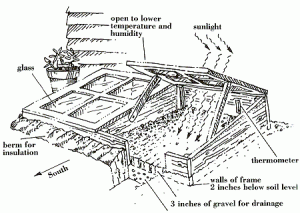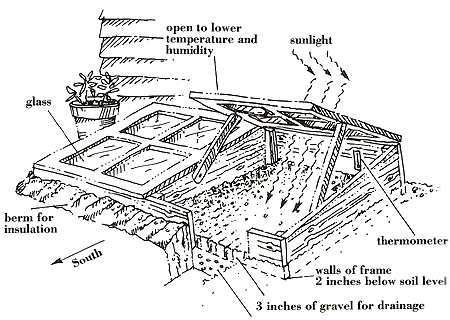Cold frames are the second most efficient environments for growing seedlings and probably the least expensive to construct and operate. There are two types of cold frames: permanent ones, and temporary ones that are dismantled after the seedlings are transplanted.
A cold frame is a wooden box with a glass, plastic, or fiberglass top. Permanent cold frames can be constructed in various sizes, but about 3 feet wide and 6 feet long is average. However, gardeners should take into consideration that the average tray for six-pack cells measures 11 by 21 inches, so the cold frame should be constructed to accommodate multiples of these measurements or other dimensions of the growing containers.

Cold frame for hot peppers
The top of the cold frame can be made of old window sashes, or a wooden frame covered with fiberglass or plastic film. Some greenhouse supply stores sell portable cold frames or pre-made sashes for cold frames. The top should be hinged so that it can be propped open during the day for ventilation. The cold frame should face south so that the top is angled to best catch the rays of the sun. It should be equipped with a thermometer and heating cables and should be sealed with weather stripping or caulking. Permanent cold frames should have good drainage, and installed heating cables covered with wire screening and sand to insure even heating.
Temporary cold frames can be constructed of cinder blocks sealed with plastic film, or from old lumber that can be knocked apart and stored after use. Either permanent or temporary cold frames can be insulated by mounding a berm of soil or sawdust around the frame. Electric light bulbs can also be installed in cold frames for additional heating.
Hotbeds are simply cold frames with heating cables installed. They are doubly useful because they can quickly germinate seeds and grow seedlings, and then their heat can be turned off so that the seedlings can harden off. During a typical spring day, the cold frame should be opened when the sun’s first rays strike it in the morning and closed in the late afternoon to retain the heat that has been absorbed inside the cold frame.
Some growers have their cold frames perform double duty in the winter as composting sites. Commonly composted materials such as kitchen vegetable scraps, rabbit manure, and other organic material is placed in the cold frame. Despite the cold outside temperatures, the solar gain in the cold frame causes the material to compost over the winter months, and it’s ready for spring planting.
Find out more on how to grow your pepper garden.
Latest posts by Mark Masker (see all)
- 2024 Scovie Awards Call for Entries - 07/07/2023
- 2024 Scovie Awards Early Bird Special: 3 Days Left - 06/29/2023
- 2024 Scovie Awards Early Bird Deadline Looms - 06/25/2023







